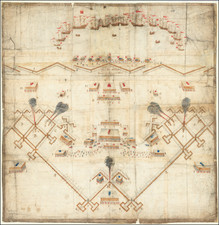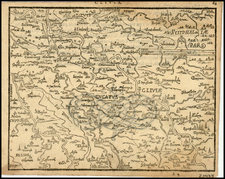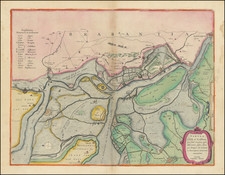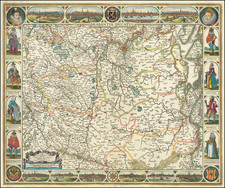Fine example of this rare engraving, illustrating the Siege of Ostend.
The image appeared in Floris Balthasar's rae "Belägerung der Statt Ostende Iournal" (1604), a comprehensive illustrated historical record of the events that transpired during this epic confrontation.
The Siege of Ostend was a protracted military confrontation in Flanders during the Eighty Years' War. Lasting from July 5, 1601, until September 20, 1604, this siege is notable for its length, the heavy casualties, and the technological innovations employed by both attackers and defenders.
Ostend was a strategic coastal city held by the Dutch rebels, and its siege was initiated by the Spanish-controlled Habsburg forces under Archduke Albert of Austria. The Spanish aimed to secure control over the Scheldt estuary and thereby cut off access to the North Sea for the Dutch provinces. However, the fortified city of Ostend stood in their way, defended by a determined garrison supported by the Dutch Republic and their English allies.
The siege saw intense military operations, including mining and countermining, the construction of elaborate siege works, and the use of floating batteries. It was also marked by the extensive use of artillery and the construction of various fortifications by the besieged to withstand the attacks. Numerous sorties, assaults, and attempts to block the port ensued, with both sides displaying great ingenuity and determination.
Despite the ferocity of the siege, the defenders managed to hold out for over three years. They were aided by the sea, which allowed for resupply and reinforcement, negating the Spanish strategy of blockade. The toll was heavy, with high casualties on both sides and great suffering among the civilian population.
In the end, the siege concluded when the defenders, exhausted and having accomplished their objective of delaying Spanish progress for years, evacuated what was left of the town after a negotiated withdrawal. The protracted conflict was costly for the Spanish as well, consuming a great deal of resources and manpower.
The Siege of Ostend was one of the longest and bloodiest sieges of the 16th century and is a testament to the evolving methods of siege warfare and military engineering of the period. The account detailed in the "Belägerung der Statt Ostende Iournal" (1604), from which the image is taken, offers a comprehensive historical record of the events that transpired during this epic confrontation.
Floris Balthasarwas a goldsmith, engraver and surveyor.
His first known work was a print of a halberdier from around 1597. In 1599 he was commissioned by the States General, on the advice of Maurits van Nassau , to record the Siege of Zaltbommel on a map. After this he was commissioned to also make a map of other military operations, such as the Battle of Nieuwpoort, the campaign of 1602, the Siege of Grave, the Siege of Sluis, the Siege of Jülik and the Battle of Gibraltar.
As a surveyor he and his son, Balthasar Florisz. van Berckenrode , three large maps for the Water Boards of Rijnland, Delfland and Schieland.














![(Second World War - The Aftermath - Abdication of Leopold III) En Pleine Guerre! Voici le Domaine dont Leopold III Revendiquait les Titres: Saxe-Cobourg-Gotha. . . [In the middle of a war! Here is the region where Leopold III Claimed Title: Saxony, Coburg, Gotha. . .]](https://storage.googleapis.com/raremaps/img/small/91010.jpg)